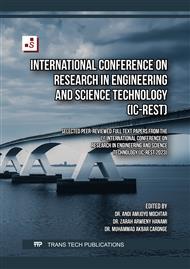[1]
Kuriansyah M Y, Juliastuti, and Suhendra, A, (2023), Risk identification for design and build breakwater project using risk breakdown structure (case study: Sanur project, Bali, Indonesia), AIP Conference Proceedings.
DOI: 10.1063/5.0112062
Google Scholar
[2]
Firdaus. A., and Amrina. U, (2023), Analyzing the gap in supply chain business process of national engineering procurement construction (EPC) company using rapid assessment procedure, AIP Conference Proceedings.
DOI: 10.1063/5.0105473
Google Scholar
[3]
Erdogan S A, Saparauskas J, and Turskis Z, (2017), Decision making in construction management: AHP and expert choice approach, Procedia Engineering, Vol 172 pp.270-276
DOI: 10.1016/j.proeng.2017.02.111
Google Scholar
[4]
Tucker S N, Mohamed S, Johnston D R, McFallan S L, and Hampson K D, (2001), Building and Construction Industries supply Chain Project (Domestic) Report for Department of Industry, Science and Resources.
Google Scholar
[5]
Konchar. M and Sanvido. V, (1998), Comparison of U.S. Project Delivery Systems, Journal of Construction Engineering and Management, Vol 124 No 6 p.435–444.
DOI: 10.1061/(asce)0733-9364(1998)124:6(435)
Google Scholar
[6]
Jalal M P, Nikkhou S, and Hoseingholi M, (2020) Challenges of the Engineering Design Partnership Group in Design-Build Contracts, Journal of Legal Affairs and Dispute Resolution in Engineering and Construction, Vol 12 Issue 3.
DOI: 10.1061/(asce)la.1943-4170.0000416
Google Scholar
[7]
Asmar M. E., Hanna A. S., and Loh. W, (2013), Quantifying Performance for the Integrated Project Delivery System as Compared to Established Delivery Systems, Journal of Construction Engineering and Management, Vol 139 Issue 3.
DOI: 10.1061/(asce)co.1943-7862.0000744
Google Scholar
[8]
Khairulzan.Y and Nabilah A. H. S., (2015), The significant factors causing delay of building construction projects in Malaysia, Malaysia Construction Journal, Vol 20 p.593–599.
Google Scholar
[9]
Chan A P C, Ho D C K, Tam C M 2001 Design and build project success factors: multivariate analysis Journal of Construction Engineering and Management Vol 127 Issue 2 p.151–168
DOI: 10.1061/(asce)0733-9364(2001)127:2(93)
Google Scholar
[10]
Xia B, Chen Q, Xu Y, Li M, and Jin. X., (2014), Design-build contractor selection for public sustainable buildings, Journal of Management in Engineering, Vol 31 Issue 5
DOI: 10.1061/(asce)me.1943-5479.0000295
Google Scholar
[11]
Heravi A, Coffey V, and Trigunarsyah B, (2015), Evaluating the level of stakeholder involvement during the project planning processes of building projects, International Journal of Project Management, Vol 33 Issue 5 p.985–997.
DOI: 10.1016/j.ijproman.2014.12.007
Google Scholar
[12]
Gransberg D. D and Molenaar K. R., (2019), Critical comparison of progressive design-build and construction manager/general contractor project delivery methods, Journal of the Transportation Research Board, Vol 2673 Issue 1 p.261–268.
DOI: 10.1177/0361198118822315
Google Scholar
[13]
Kasmita K. J., (2018), Design-Build Theory Yogyakarta: Islamic University Of Indonesia
Google Scholar
[14]
Toni. A., (2011), Identification of risks at PT.XYZ affects time performance In Indonesia , Jakarta: Universitas Indonesia.
Google Scholar
[15]
Migliaccio G C, Bogus S M, and Chen .A., (2011), Effect of Duration of Design–Build Procurement on Performance of Transportation Projects, Transportation Research Record, Vol 2151 Issue 1 p.67–73.
DOI: 10.3141/2151-09
Google Scholar
[16]
Shrestha P P, Migliaccio G C O, O'Connor J T, and Gibson G E, (2007), Benchmarking of Large Design–Build Highway Projects: One-to-One Comparison and Comparison with Design–Bid–Build Projects, Transportation Research Record ,Vol 1994 Issue 1 p.17–25.
DOI: 10.3141/1994-03
Google Scholar
[17]
Pujawan I N, (2005), Supply Chain Management Surabaya: Guna Widya
Google Scholar
[18]
Modupe A O, Emmanuel O O, Agnes S O, and Ayodele M. B., (2012), Impact of Risk on Performance of Design and Build Projects in Lagos State, Nigeria Journal of civil engineering and architecture, Vol 6 No. 9 pp.1210-1217.
DOI: 10.17265/1934-7359/2012.09.013
Google Scholar
[19]
Project Management Institute (2003) The Construction Extension to the PMBOK PA: Project Management Institute.
Google Scholar
[20]
Pujawan. I. N, and Geraldin L. H., (2009) House of risk: A model for Proactive Supply Chain Risk Management, Business Process Management Journal, Vol 15 Issue 6 p.953 – 967.
DOI: 10.1108/14637150911003801
Google Scholar
[21]
Park. J and Kwak. Y. H., (2017), Design-bid-build (DBB) vs. design-build (DB) in the US public transportation projects: the choice and consequences, International Journal of Project Management, Vol 35 Issue 3 p.280–295.
DOI: 10.1016/j.ijproman.2016.10.013
Google Scholar
[22]
Liu J, Xie Q, Xia B, and Bridge A J 2017 Impact of Design Risk on the Performance of Design-Build Projects Journal of Construction Engineering and Management Vol 143 No 6.
DOI: 10.1061/(asce)co.1943-7862.0001299
Google Scholar
[23]
Kalach A V, Akulov A Y, and Cherepanov E. A., (2020 ), Integrated Fire Risk Factors Analysis in the Residential Districts of Russian Federation Regions, IOP Conference Series: Earth and Environmental Science, Vol 459 Chapter 3.
DOI: 10.1088/1755-1315/459/4/042045
Google Scholar
[24]
Shen Y, Xu M, Lin Y, Cui C, Shi X, and Liu. Y., (2022), Safety Risk Management of Prefabricated Building Construction Based on Ontology Technology in the BIM Environment, Buildings, Vol 12 Issue 6.
DOI: 10.3390/buildings12060765
Google Scholar
[25]
Aslam M, Baffoe-Twum E, and Saleem. F., (2019), Design Changes in Construction Projects – Causes and Impact on the Cost, Civil Engineering Journal, Vol 5 No 7 pp.1647-1655
DOI: 10.28991/cej-2019-03091360
Google Scholar
[26]
Nguyen P. T. and Nguyen. P., (2020), Risk Management in Engineering and Construction A Case Study in Design-Build Projects in Vietnam Engineering, Technology and Applied Science Research, Vol 10 Issue 1 pp.5237-5241.
DOI: 10.48084/etasr.3286
Google Scholar
[27]
Rostiyanti S, Koesalamwardi A B, and Winata. C., (2019), Identification of design-build project risk factors: contractor's perspective, MATEC Web ConferenceI, Vol 276.
DOI: 10.1051/matecconf/201927602017
Google Scholar
[28]
Yuristanti T, Wiguna I P A, and Budianto. H., (2020), Analysis of Project Performance Criteria for Design and Build Contract, Journal of Infrastructure & Asset Management, Vol 2 No 2.
DOI: 10.12962/jifam.v2i2.6945
Google Scholar



